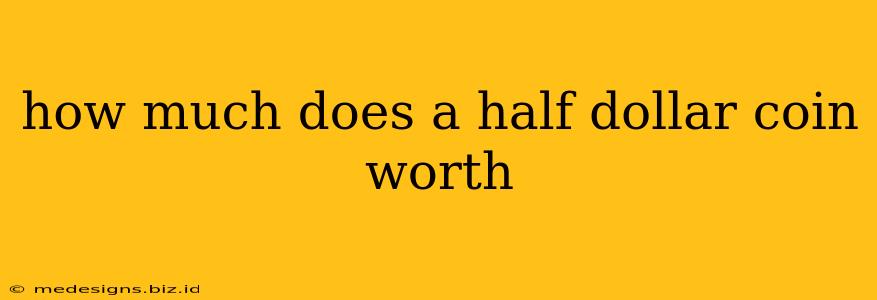The value of a half dollar coin isn't simply 50 cents. Its worth depends heavily on several factors, making it a fascinating area for both casual collectors and serious numismatists. This guide will explore what determines the value of your half dollar and how to determine its potential worth.
Factors Affecting Half Dollar Coin Value
Several key factors influence the value of a half dollar coin beyond its face value:
1. Year and Mint Mark:
The year a coin was minted and its mint mark (a small letter indicating the mint where it was produced – e.g., D for Denver, S for San Francisco) significantly impact its worth. Certain years produced fewer coins, making those particular years more valuable to collectors. Rare mint marks can also boost a coin's price. For example, a 1964 Kennedy half dollar in uncirculated condition can be worth significantly more than its face value.
2. Condition (Grade):
The condition, or grade, of your half dollar is arguably the most crucial factor determining its value. Coins are graded on a scale that considers factors like wear, scratches, and overall appearance. A coin in uncirculated (MS) condition, meaning it shows no signs of circulation, will be worth far more than a coin in worn (G) condition. Professional grading services provide accurate assessments, but online resources can offer guidance for preliminary evaluations. Learning to identify key characteristics of different grades is essential for understanding your coin's value.
3. Type of Half Dollar:
The type of half dollar coin significantly impacts its value. Different designs and historical significance impact collectability. For example, Walking Liberty half dollars and Barber half dollars are highly sought after by collectors and command significantly higher prices than more common Kennedy half dollars, even in circulated condition. Understanding the different types of half dollar coins and their historical significance is important for assessing value.
4. Rarity and Demand:
The rarity of a specific coin contributes to its value. Low mintage numbers or high collector demand can drive up prices. Specific error coins, those with unique minting errors, can become extremely valuable. Understanding the rarity of your coin through resources dedicated to numismatics can assist in determining its worth.
5. Silver Content:
Many older half dollars contain a significant amount of silver. The price of silver fluctuates, affecting the melt value of these coins. Before 1965, half dollars were 90% silver, meaning their silver content alone might contribute significantly to their current value. However, consider the legal implications before melting down any coin.
How to Determine the Value of Your Half Dollar
Several resources can help you determine the value of your half dollar:
- Online Coin Price Guides: Many websites provide price guides and databases of coin values, allowing you to look up your coin's specifications to get an estimate.
- Professional Grading Services: Professional numismatists provide accurate grading and appraisal services. While costly, it's highly recommended for valuable coins.
- Coin Dealers and Auction Houses: Consulting with experienced coin dealers or checking prices at coin auctions can provide insights into the current market value.
Remember: Online price guides offer estimates; the actual value can vary depending on the specific condition and current market demand. Always handle your coins carefully to preserve their condition and potential value.
Conclusion
The worth of a half dollar coin extends far beyond its face value. Factors such as year, mint mark, condition, type, rarity, and silver content all play crucial roles in determining its value. By understanding these factors and utilizing available resources, you can accurately assess the worth of your half dollar and discover the fascinating world of numismatics.
